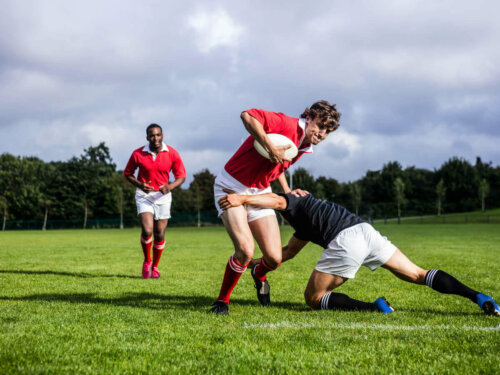Sports-Related Facial Fractures

Sports, especially contact sports, can cause facial fractures, as well as fractures on other body parts. However, skull and facial fractures can be much more serious, since they house very important and delicate organs.
Combat sports cause most of these types of injuries. Those who practice them know that this is the case and take the corresponding precautions. However, blows are sometimes unavoidable in certain contexts. It’s vital for them to be treated promptly.
Prevalence of sports-related facial fractures
Trauma to the face and skull is associated with car accidents. In fact, this is where the greatest number of maxillofacial fractures occur. Nevertheless, some epidemiological studies registered up to 18 percent incidence in sports.
Some of the sports that cause the most facial fractures are rugby, soccer, karate, ice hockey, and boxing. Although, this varies for each geographical area and country, according to the most popular sport in each place.
Young men suffer the most from sports-related maxillofacial fractures. Experts assume that this is because of the types of activities they prefer. Young people tend to opt for contact sports that require force.
The most common facial fractures among athletes
Various investigations, such as one published by OMC – Otorhinolaryngology in 2019, revealed the epidemiology of sports-related facial fractures. It concluded that the bones of the nose are the most affected. Dental and fractures of the jaw are in second place.

The nose has three bony structures and the rest of its tissues are soft and cartilaginous. It has two small, fragile bones in the upper area and a section of the internal nasal septum consists of several bones.
A so-called nose fracture affects the bones. In this case, inflammation and bruising immediately appear, denoting the rupture of the small vessels.
The swelling can be substantial, so much so that it can hinder the passage of air when it results in a blockage of the nasal passages. Also, deformation appears and, if the trauma is severe, the impact can even deviate the septum.
When the septum deviates due to a nasal fracture, there’s a risk that the cartilage will also break. This results in a need for surgery, as the respiratory discomfort becomes unbearable over time.
Fracture of the jaw or mandibular fracture
The second most prevalent traumatic facial events are mandibular fractures. This bone is the lower jaw, which not only forms the oral cavity but also gives it consistency and contains the teeth.
In general, the jaw is a strong and solid bone. However, it has some weak spots. One of these areas is the condyle, where it articulates with the rest of the skull to allow chewing. Fractures are much more common there.
Also, an athlete may suffer from a dental or oral condition that weakens the jawbone. Residual cysts, long tooth roots, and chronic abscesses that collect pus inside the bone cavity are prone to fractures.
The pain that these fractures cause is noticeable and almost immediate. Likewise, a facial deformation that prevents functionality can occur. Thus, the patient can’t eat or drink normally. It doesn’t always alter speech, However, if you have a hard time articulating words, then you’re probably facing a more serious injury.

Treatment of sports-related facial fractures
The therapeutic approach is varied and depends on the severity and location of the fracture.
Nasal fractures can range from mild symptoms that only require an external splint and rest, to septum deviations that require surgery. A trauma specialist determines this based on complementary methods, such as X-rays and CT scans, that reveal the extent of the injury.
A mandibular fracture requires more complex treatment. Repair surgeries involve specific interventions with internal repair and external metal braces. The patient must modify their eating habits while they recover, only following a bland diet, as they can’t chew.
Physical therapy is relative. In the case of the lower jaw, if the rest period was prolonged, the masseter muscles, on the rear part of each cheek, may atrophy. In those cases, the goal of physical therapy is to restore muscle strength. Meanwhile, kinesiology isn’t usually required for the nasal area.
Immediate care for a speedy recovery
Sports-related facial fractures require immediate treatment. Prompt attention and diagnostic guidelines that determine severity are key. Trauma specialists can establish a treatment plan based on their evaluation.
In addition, being careful when you practice sports is essential to prevent these serious injuries. The use of protective gear during practices and the application of the rules of fair play protect athletes.
Sports, especially contact sports, can cause facial fractures, as well as fractures on other body parts. However, skull and facial fractures can be much more serious, since they house very important and delicate organs.
Combat sports cause most of these types of injuries. Those who practice them know that this is the case and take the corresponding precautions. However, blows are sometimes unavoidable in certain contexts. It’s vital for them to be treated promptly.
Prevalence of sports-related facial fractures
Trauma to the face and skull is associated with car accidents. In fact, this is where the greatest number of maxillofacial fractures occur. Nevertheless, some epidemiological studies registered up to 18 percent incidence in sports.
Some of the sports that cause the most facial fractures are rugby, soccer, karate, ice hockey, and boxing. Although, this varies for each geographical area and country, according to the most popular sport in each place.
Young men suffer the most from sports-related maxillofacial fractures. Experts assume that this is because of the types of activities they prefer. Young people tend to opt for contact sports that require force.
The most common facial fractures among athletes
Various investigations, such as one published by OMC – Otorhinolaryngology in 2019, revealed the epidemiology of sports-related facial fractures. It concluded that the bones of the nose are the most affected. Dental and fractures of the jaw are in second place.

The nose has three bony structures and the rest of its tissues are soft and cartilaginous. It has two small, fragile bones in the upper area and a section of the internal nasal septum consists of several bones.
A so-called nose fracture affects the bones. In this case, inflammation and bruising immediately appear, denoting the rupture of the small vessels.
The swelling can be substantial, so much so that it can hinder the passage of air when it results in a blockage of the nasal passages. Also, deformation appears and, if the trauma is severe, the impact can even deviate the septum.
When the septum deviates due to a nasal fracture, there’s a risk that the cartilage will also break. This results in a need for surgery, as the respiratory discomfort becomes unbearable over time.
Fracture of the jaw or mandibular fracture
The second most prevalent traumatic facial events are mandibular fractures. This bone is the lower jaw, which not only forms the oral cavity but also gives it consistency and contains the teeth.
In general, the jaw is a strong and solid bone. However, it has some weak spots. One of these areas is the condyle, where it articulates with the rest of the skull to allow chewing. Fractures are much more common there.
Also, an athlete may suffer from a dental or oral condition that weakens the jawbone. Residual cysts, long tooth roots, and chronic abscesses that collect pus inside the bone cavity are prone to fractures.
The pain that these fractures cause is noticeable and almost immediate. Likewise, a facial deformation that prevents functionality can occur. Thus, the patient can’t eat or drink normally. It doesn’t always alter speech, However, if you have a hard time articulating words, then you’re probably facing a more serious injury.

Treatment of sports-related facial fractures
The therapeutic approach is varied and depends on the severity and location of the fracture.
Nasal fractures can range from mild symptoms that only require an external splint and rest, to septum deviations that require surgery. A trauma specialist determines this based on complementary methods, such as X-rays and CT scans, that reveal the extent of the injury.
A mandibular fracture requires more complex treatment. Repair surgeries involve specific interventions with internal repair and external metal braces. The patient must modify their eating habits while they recover, only following a bland diet, as they can’t chew.
Physical therapy is relative. In the case of the lower jaw, if the rest period was prolonged, the masseter muscles, on the rear part of each cheek, may atrophy. In those cases, the goal of physical therapy is to restore muscle strength. Meanwhile, kinesiology isn’t usually required for the nasal area.
Immediate care for a speedy recovery
Sports-related facial fractures require immediate treatment. Prompt attention and diagnostic guidelines that determine severity are key. Trauma specialists can establish a treatment plan based on their evaluation.
In addition, being careful when you practice sports is essential to prevent these serious injuries. The use of protective gear during practices and the application of the rules of fair play protect athletes.
All cited sources were thoroughly reviewed by our team to ensure their quality, reliability, currency, and validity. The bibliography of this article was considered reliable and of academic or scientific accuracy.
- Díaz Fernández, José Manuel, Manuel Kindelán Lusson, and Maximiliano Freddy Gámez Rodríguez. Prevalencia de fracturas faciales vinculadas con el deporte. Revista Cubana de Estomatología 41.2 (2004): 0-0.
- de Pablo Màrquez, Bernat, Adaia Valls Ontañón, and Gil Rodas Font. Fracturas mandibulares: manejo en deportistas. Apunts. Medicina de l’Esport 52.195 (2017): 123-127.
- Quintana, Juan Carlos, et al. Incidencia de fracturas dento-maxilofaciales ocurridas en la práctica del béisbol. Acta Odontológica Colombiana 6.2 (2016): 23-30.
- Estomba, Rossana Chiesa, et al. Fractura de estrés de cadera en adulto no entrenado tras actividad deportiva intensa. Reporte de caso. Revista Colombiana de Ortopedia y Traumatología (2020).
- Escobedo Escobedo, Abner. Odontología deportiva y prevención de trauma dentoalveolar. Revista de la Asociación Dental Mexicana 76.6 (2019): 328-331.
This text is provided for informational purposes only and does not replace consultation with a professional. If in doubt, consult your specialist.








